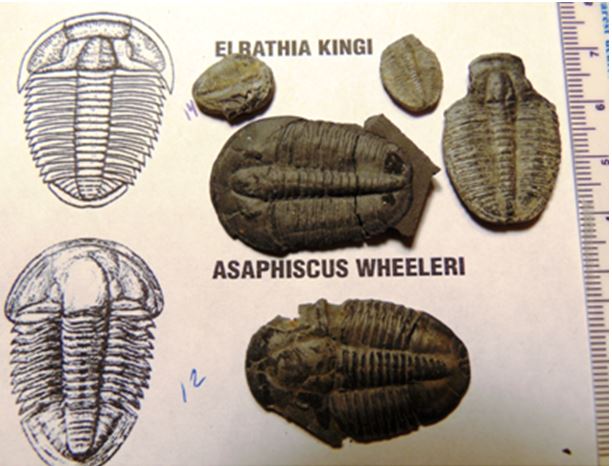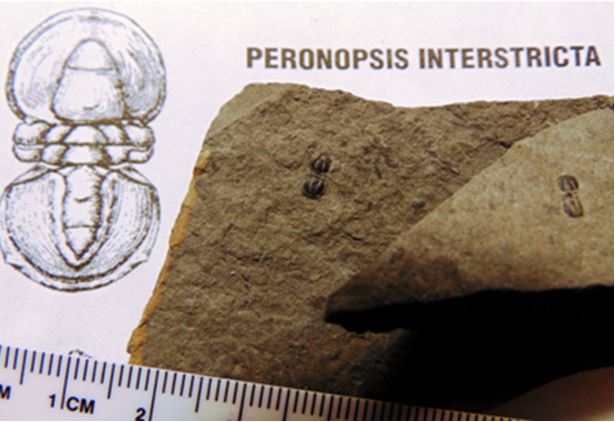Many thanks to Stephen Mayer for writing this collecting trip note for the August WCGMC newsletter and also for allowing me to post it my blog.
By Stephen Mayer
Tammy and I are back from a vacation in the desert southwest. Naturally, we took some time between visits to National Parks to do a little fossil and mineral collecting in Utah. The setting and geology are quite different than in western New York.
Very thick shale and calcareous mudstones are widespread in Millard County, west-central Utah and contain some of the best Cambrian biotas in the world. Not only are there 505-520 million year old fossils abundant, but also recent volcanism in the same region has left its mark with abundant rocks and minerals. Specifically, well preserved trilobites and beautiful topaz crystals can be collected.
TRILOBITES: Early in human history, necklaces made of trilobites were regarded by the Pahvant Indians as “protecting the body from sickness and weapons of death as long as a man’s heart is pure” (Robison, Babcock, and Gunther, 2015). Early geologists extensively studied the stratigraphy and paleontology of the region. In the 1870’s Army Lieutenant George Wheeler named a bowl-shaped area in the House Range the Wheeler Amphitheater and comprising the Wheeler Shale. Subsequently from the 1880’s –1900’s Charles Walcott (born in Upstate New York and employed by James Hall) published many reports of the rocks and fossils of the Cambrian strata (i.e. Walcott, 1886, 1890). Today there are numerous private and public enterprises with land claims near Delta, Utah to collect these fossils.
U-Dig Fossils is probably the best known of these quarries. About 32 miles west of Delta and 20 miles north on a maintained gravel road, is a small shed adjacent to a cliff face. For a small fee, amateurs and professionals can collect trilobites. Pickings are easy, all one needs to do is look at their feet, but if one prefers, they can remove new blocks of rock from the outcrop. The trick is not finding a trilobite but instead finding that perfect specimen. In a four hour period, hundreds of partial trilobites will be seen, and maybe 3-5 really nice examples can be collected. Elrathia kingii, Asaphiscus wheeleri and Peronopsis interstricta are all fairly common and we found examples of each However, Bolaspidella housensis, Altiocculus harrisi, and Olenoides nevadaensis are quite rare. The majority of the trilobite fossils uncovered are molts, however, complete, immature (1-2 mm) to adult (2 cm) forms are there for the persistent collector. Additionally, lingulid brachiopods, Phyllocarids, and algae (black polka dots on the shale) can be found. We were even lucky enough to uncover and recover a mortality plate with multiple Elrahia kingi. The plate in the cover photograph above is 9 cm. across.


TOPAZ: Throughout western Utah, approximately 6-7 million years ago, volcanic rocks erupted spewing basaltic lava flows and building mountains composed of rhyolite. The most famous location is called Topaz Mountain which is about 2 hours northeast of U-Dig Fossils and 1½ hours northwest of Delta. This desert locality is truly in the “middle of nowhere”. After traveling about 30 miles on a poorly maintained dirt road, it really becomes interesting. One can see the locality a mile away, but how does one get there? The answer is a dirt road of course. Well, that is until proceeding the first 20 feet and realizing the path is nothing more than a dry streambed. In places the path is as wide as a car but half of the width is at a 30 degree angle and the other half of the width is marked by large rocks and potholes. Certainly, speed is of the essence here and 1 mile consumes 1 hour!
An excellent guide meets the prospector (who has made prior arrangements and paid a nominal fee) at a 4-pole 10 ft by 10 ft sunshade. Together, they climb a rubble field of rhyolite, which has been previously blasted from the mountain. The companion dog seemingly unaware of the extremely steep rock face stays with the guide the entire time. Everyone is looking for beautifully terminated topaz crystals. They break open vugs in the rhyolite exposing amber colored crystals, the color imparted from gamma radiation emitted by uranium in the rocks. Although most crystals are small (less than a ¼ inch) a few reach lengths of an inch or more. Additionally quartz, calcite, garnet, hematite, obsidian, and other minerals occur on Topaz Mountain.

References:
Robison, R.A., Babcock, L.E. and Gunther, V.G., 2015. Exceptional Cambrian Fossils from Utah: A Window into the Age of Trilobites, Utah Dept. of Natural Resources, Miscellaneous Pub. 15-1. Utah Geological Survey.
Walcott, C.D., 1886, Second Contribution on the Cambrian faunas of North America, USGS Bulletin #30, 369 p.
Walcott, C.D., 1890, Correlation Papers on the Cambrian, USGS Bulletin #81, 447 p.
